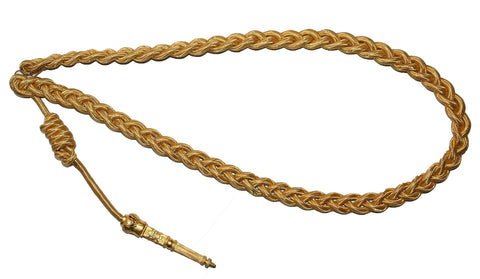Army Shoulder Cords & Color Meanings

Have you ever seen a U.S. Army soldier with a nylon cord hanging from his or her shoulder? Have you thought about the meaning of Army shoulder cords?
Although one Army shoulder cord in particular stands out in the U.S. Army, there are several Army shoulder cords that can be worn on an Army uniform, but there is a big difference between them. Most, however, require a special duty assignment that we will cover later in this blog post. But for now, let’s talk about the meaning of Army shoulder cords
Army Shoulder Cords per Regulation
The Army Shoulder Cord is intended to be worn on the Class A dress blue uniform jacket or Class B shirt. According to the most recent version of the Army Regulation 670-1 (AR 670-1), the blue infantry cord is the only shoulder cord currently authorized for wear on any Army uniform. The other colored cords, corresponding to the different army branches, can be authorized by unit commanders to be worn during particular events.
Simply put, if you see a soldier wearing a blue cord on their uniform, the meaning of Army shoulder cords they are wearing signifies they are likely in the infantry.
Meaning of Army Shoulder Cords in History
The history of shoulder cords in the U.S. military dates back to World War II. They were originally worn as a mark of distinction, denoting membership in a combat unit or participation in a specific campaign. Over time, their meaning has evolved to encompass a wider array of significances, yet the ethos of recognition and accomplishment remains the same.
But the meaning of Army shoulder cords evolved over time throughout the history of militaries throughout the world. The U.S. Army did not really embrace the shoulder cords until around World War II.
In the vast sea of military uniforms, the shoulder cord is a small but powerful detail, often unspoken in its significance. This slender adornment carries with it a language of its own, communicating a soldier’s feats, affiliations, and honors.
How the Cord is Worn
Now that we know the meaning of Army shoulder cords, we should probably mention how they are worn. The shoulder cord is worn on the right shoulder and is passed under the arm and over the right shoulder under the shoulder loop, and secured to the button on the shoulder loop. In order to attach the cord, personnel will attach a 20-ligne button to the right shoulder seam, 1/2 inch outside the collar edge.
Colors and their Meanings
What is the meaning of Army shoulder cords that have various colors? Well, let the confusion begin. As previously mentioned, the Army only authorizes one cord, and that’s the infantry blue cord, but there are other opportunities to wear shoulder cords that come in various colors. Each represents different achievements and roles within the Army. It’s not just the color that tells a story; the way in which the cords are braided and the arrangement of knots also carry deep symbolic meaning.
Infantry Blue Cord
Infantrymen are known for their blue cord, signifying their role as the backbone of the U.S. Army. This cord is reserved for those who have completed the rigorous training and subsequently served in various infantry roles.
Artillery Red, Black, and Gold Cord
The meaning of Army shoulder cords that are red, black, and gold is that the person wearing them is in an artillery unit. This reflects the core values and history of the artillery as a crucial force on the battlefield. Now, as mentioned earlier, the Army does not authorize soldiers to wear cords like the infantry, however, the uniform regulation does state that local commanders can authorize soldiers to wear a cord for special occasions or duties.
Armor Units Traditional Yellow Shoulder Cord
What is the meaning of Army shoulder cords that are yellow? This means that the person wearing the cord is in an armor unit, a nod to the color that has identified armored cavalry for many years.
Knots
The meaning of Army shoulder cords with knots has special symbolism. The braiding of knots along the cord isn’t just about aesthetics; each knot represents a specific rank or accomplishment achieved by the wearer. A single knot may denote the completion of basic training, a significant step in a soldier’s career, where the transition from civilian to military life is pivotal. Multiple knots could signify more advanced training or a longer tenure in a particular unit.
Looking Forward
The tradition and symbolism behind army shoulder cords are enduring, but they are not static. The cords continue to adapt, incorporating new meanings and conversations reflective of the modern military landscape.

Conclusion
Shoulder cords are more than mere fabric; they're weaves of history and identity. These seemingly simple adornments have the power to bond wearers to their past, present, and future as soldiers. They remind each individual of their unique contribution to the collective power of the U.S. Army, and they communicate that story to the world.
Lastly, the “aiguillette,” is worn on the left shoulder by military aides to the president and the vice president of the United States. It is worn on the left shoulder by military assistants to the secretary of defense and the secretary of homeland security, aides to the service secretaries, military attachés, general staff corps officers, and aides to flag officers. The Army wears gold-colored cords for the aforementioned positions. Other services also wear aiguillettes that are specific to particular billets a service member occupies.
Fourrageres and lanyards. Permanent and temporary fourrageres and lanyards may be worn on the service/dress uniform per the provisions of AR 600–8–22. Only one fourragere, lanyard, aiguillette, or cord is authorized for wear on each shoulder.


